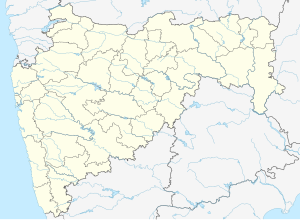Murud-Janjira
18°17′59″N 72°57′51″E / 18.299773°N 72.964239°E
| Murud Janjira | |
|---|---|
| Raigad district, Maharashtra | |
 Murud Janjiraa bastions | |
| Coordinates | 18°17′59″N 72°57′51″E / 18.299773°N 72.964239°E |
| Type | Island fort |
| Site information | |
| Owner | Government of India |
| Controlled by | Siddis |
| Open to the public | Yes |
| Condition | Partially intact |
| Site history | |
| Built | 1490 |
| Materials | Stone |
Murud-Janjira is the local name for a fort situated at the coastal village of Murud, in the Raigad district of Maharashtra, India.[1] It is famous for being the only fort along India's western coast that remained undefeated despite Dutch and English East India Company attacks.
Origins of the name
The word Janjira is not native to India, and may have originated after the Arabic word Jazeera, which means an island. Murud was once known in Marathi as Habsan ("of Habshi" or Abyssinian). Some of the people also split the name as "Jal Jeera" meaning fort in the water.[citation needed]
The name of the fort is a concatenation of the Konkani and Arabic words for Island, "morod" and "jazeera". The word "morod" is peculiar to Konkani and is absent in Marathi. Thus, during the rains, the fields get flooded, but the morods never flood. The State of Murud-Janjira was known to the Maratha Empire as Habsan, the land of the Habshis.
Major features
Murud-Janjira Fort situated on a rock of oval shape near the port town of Murud, 165km south of Mumbai, Janjira is one of the strongest marine forts of India (the word ‘Janjira’ is a corruption of the Arabic word Jazira for island). The forts is approached by sailboats from Rajapuri jetty. The main gate of the fort faces Rajapuri on the shore and can be seen only when one is quite close to it. It has a small postern gate towards the open sea for escape.
The fort has 19 rounded bastions, still intact. There are many canons of native and European make rusting on the bastions. Now in ruins, the fort in its heyday had all necessary facilities, e.g., palaces, quarters for officers, mosque, a big fresh water tank, etc. On the outer wall flanking the main gate, there is a sculpture depicting a tiger-like beast clasping elephants in its claws. This sculpture, its meaning difficult to interpret, appears on many fort-gates of Maharashtra.
Originally the fort was small wooden structure built by a Koli chief in the late 15th century. It was captured by Pir Khan, a general of Nizamshah of Ahmednagar. Later the fort was strengthened by Malik Ambar, the Abyssinian Siddi regent of Ahmednagar kings. From then onward Siddis became independent, owing allegiance to Adilshah and the Mughals as dictated by the times. Despite their repeated attempts, the Portuguese, the British and the Marathas failed to subdue the Siddi power. Shivaji’s all attempts to capture Janjira fort failed due to one reason or the other.
When Sambhaji also failed, he built another island fort, known as Kansa or Padmadurg, just 9km north of Janjira. The Janjira state came to an end after 1947. The palace of the Nawabs of Janjira at Murud is still in good shape.
See also
References
- ^ Hoiberg, Dale (2000). Students' Britannica India. Popular Prakashan. p. 403. ISBN 0852297629. Retrieved 2009-03-17.
{{cite book}}: Unknown parameter|coauthors=ignored (|author=suggested) (help)

